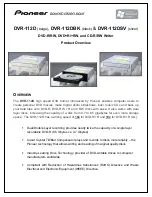
The noise in this part is divided into two types: one is the radiated interference
of the inverter, and the other is the conducted interference of the inverter.
These two kinds of interference make the surrounding electrical equipment
subject to electromagnetic or electrostatic induction. This in turn causes the
device to malfunction. For several different interference situations, refer to the
following solutions:
Instruments, receivers and sensors used for measurement generally have
weak signals. If they are close to the inverter or in the same control cabinet,
they are prone to interference and malfunction. It is recommended to use the
following solutions: try to Keep away from interference sources; do not arran-
ge signal lines and power lines in parallel, especially do not bundle them in
parallel; use shielded lines for signal lines and power lines, and the grounding
is good; add a ferrite magnetic ring to the output side of the inverter (select
the suppression frequency at 30~1000MHz range), and winding 2~3 turns in
the same direction, for bad conditions, you can choose to install an EMC ou-
tput filter;
When the interfered equipment and the inverter use the same power supply, it
will cause conduction interference. If the above methods cannot eliminate the
interference, an EMC filter should be installed between the inverter and the
power supply (refer to 7.3.6 for details). type operation);
The peripheral equipment is grounded separately, which can eliminate the int-
erference caused by the leakage current of the ground wire of the inverter
when the ground is shared.
Chapter 8 EMC (Electromagnetic Compatibility)
-252-
8.3.5 Leakage Current and Handling
There are two forms of leakage current when using the inverter: one is the leakage
current to the ground; the other is the leakage current between lines.
Factors affecting ground leakage current and solutions:
There is a distributed capacitance between the wire and the ground. The larg-
er the distributed capacitance, the larger the leakage current; effectively redu-
ce the distance between the inverter and the motor to reduce the distributed
capacitance. The greater the carrier frequency, the greater the leakage curr-
ent. The carrier frequency can be lowered to reduce leakage current.
C
h
a
p
te
r
8
Summary of Contents for 2S-0.4G-B
Page 6: ...Safety and Attentions Chapter 1 1 1 Safety Matters 6 1 2 Use Considerations 9...
Page 80: ...Function Parameter Table 5 1 Functional group 78 Chapter 5...
Page 126: ...Function Parameter Table Chapter 6...
Page 245: ......
Page 249: ......
Page 255: ......
















































